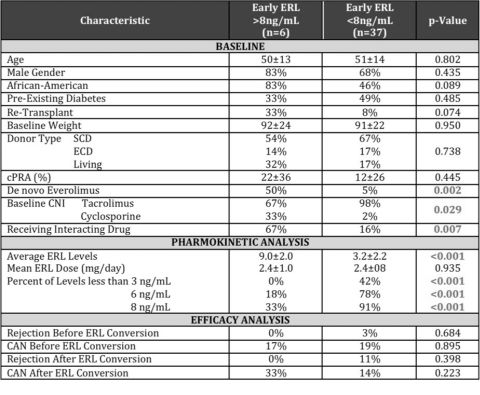Early Elevated Everolimus Levels Are Associated with More Toxicities without Improved Efficacy
Transplant, MUSC, Charleston, SC
Meeting: 2013 American Transplant Congress
Abstract number: D1490
Background: Everolimus (ERL) is an mTOR generally utilized in CNI minimization or withdrawal regimens for kidney transplantation (KTX). The aim of this study was to compare pharmacokinetic (PK) and pharmacodynamic (PD) properties of everolimus in the early initiation period.
Methods: This was a retrospective cross-sectional PK/PD analysis of all patients that received ERL within our transplant center between 2005 and 2011. Pediatrics, multi-organ transplants, and those with limited or no ERL concentrations were excluded. Univariate and multivariate analysis was conducted to determine which PK parameters were associated with ERL efficacy and toxicities.
Results: 43 patients received ERL and were included. The majority of patients were converted to an ERL based regimen with CNI withdrawal for nephrotoxicity. Patients were elevated ERL levels in the first 2 months after initiation were more likely to receive ERL de novo, be on cyclosporine concomitantly or at the time of conversion and receive an interacting medication (diltiazem or fluconazole). Patients with early elevated ERL levels were more likely to remain with higher levels throughout follow-up. Acute rejection was similar between groups; however, patients with early elevated ERL levels were 1.9 times more likely to develop proteinuria (p=0.163) and 3.2 times more likely to be readmitted to the hospital (p=0.073).
Conclusions: Patients that receive CyA, de novo everolimus, and interacting drugs are significantly more likely to have early elevated everolimus levels, which may be associated with a higher rate of proteinuria and readmission to the hospital. Further studies are warranted to better categorized the balance between toxicity and efficacy dosing and monitoring with ERL in KTX.

To cite this abstract in AMA style:
Taber D, Belk L, McGillicuddy J, Bratton C, Pilch N, Baliga P, Chavin K. Early Elevated Everolimus Levels Are Associated with More Toxicities without Improved Efficacy [abstract]. Am J Transplant. 2013; 13 (suppl 5). https://atcmeetingabstracts.com/abstract/early-elevated-everolimus-levels-are-associated-with-more-toxicities-without-improved-efficacy/. Accessed December 9, 2025.« Back to 2013 American Transplant Congress
